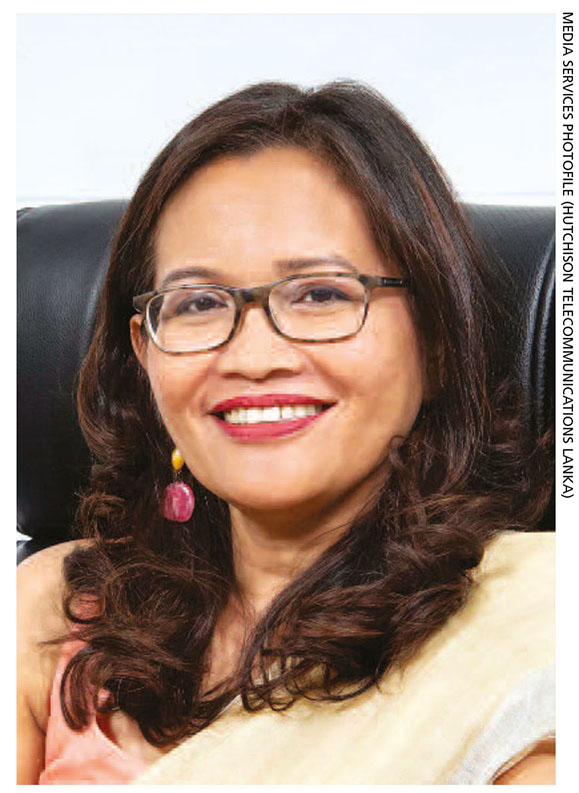TELECOM INDUSTRY
Compiled by Yamini Sequeira
A RING OF TELCO SUCCESS
Ramzeena Morseth Lye believes telecom should drive the economy
Q: How is the mobile telephony sector poised at present?
A: Currently [at the time of the interview], the telecom industry in Sri Lanka is experiencing a relatively stable and turmoil free environment, and is poised to grow especially on the mobile broadband front. Today, there are four market operators compared to five,  which helps reduce the hyper-competitive environment.
which helps reduce the hyper-competitive environment.
Nevertheless, the industry continues to be competitive thanks to some of the lowest tariffs in the world.
The voice market is saturated and much of the future growth opportunities lie in the ever increasing demand for wireless broadband data – and all indications are that demand will grow exponentially over the next five years.
Smartphone penetration remains below 50 percent, adding to the positive future outlook for the data business. However, earning an acceptable ROI continues to be a challenge due to yields crashing and competitive activities vying for what is a limited customer base.
Q: What are the latest technologies to enter the local market and how do they compare with the regional mobile sector?
A: Sri Lanka has always been ahead of many of its South Asian peers on the technology front; it was the first to launch 2G, 3G and 4G.
Asian markets such as South Korea and China have already commercially launched 5G. Several Sri Lankan operators have conducted 5G trials and are presently in consultation with the Telecommunications Regulatory Commission (TRC) to launch 5G commercial services.
Q: And what are the future growth areas for mobile operators?
A: Much of the future growth will come from mobile broadband with demand arising from a number of segments.
These include the consumer sector with video content becoming richer and more abundant, and consumers more open to embracing e-commerce, digital wallets and so on. In addition, there are digitisation efforts by the government with plans for the state sector from healthcare to education, agriculture, emigration and immigration.
There are government plans to use technology to build smart infrastructure – a requirement for smart city planning, smart transportation and so on. Industrial applications using AI are also on the rise due to labour and skill shortages, and with organisations driving cost optimisation strategies.
Q: Is the government investing enough to expand telecom capability in the country?
A: Insufficient broadband spectrum can become a major obstacle in capacity building for future demand. The government must accelerate the release of more spectrum used by other sectors (such as radio and TV broadcasting), occupying strong spectrum bands for the telecom industry to facilitate the national digitisation initiative.
Telecommunications is one of the most taxed industries in the country. Tax rates and complexities must be reconsidered, to drive consumption and encourage further investment. The recent reductions in consumer telecom taxes are welcomed although the industry itself is heavily burdened by levies such as the tower tax.
Q: Do you believe that there is adequate scope for the growth of all operators?
A: Previously, a five operator market left service providers engaging in hyper competition, which directly impacted revenue and EBITDA growth. As a result, shareholder sentiment vis-à-vis investment has been low.
Although the present four operator market has eased competition to some extent, prices are crashing. And this has a direct impact on profitability. Moreover, a lack of adequate broadband spectrum makes even a four operator market unsustainable beyond the next three to four years.
Given Sri Lanka’s relatively small population and geography, further consolidation to three operators will place the industry in a better position.
Q: What are the roadblocks to growth among mobile operators in the island?
A: Amid technology evolving, the capital expenditure requirement is high. On the other hand, due to heavy competition and yields crashing, it is difficult to invest in the future. Inadequate spectrum availability and restrictions on site acquisitions also inhibit the industry from reaching its full potential.
Q: How do you view the future of fixed line telephony?
A: With mobile device penetration growing rapidly, the use of mobile phones has become a necessity for voice calls, so much so that fixed telephone lines are no longer viewed as a household need. Many people are switching from traditional voice to data calls over OTT apps due to cost advantages, convenience and global reach.
The future of fixed line telephony lies in household broadband services as it can offer higher speeds for home or family requirements.
Q: And what are the global trends in mobile telephony?
A: The global trend in mobile technology is certainly towards 5G. However, it remains to be seen if the incremental benefits compared to 4G can support such a substantial investment to deliver returns.
Indeed, the mobile sector is one of the few that have steadily reduced telecom charges while delivering the latest technologies and services. As a major GDP growth driver, the industry should be supported in its future investments and not be viewed as a cash cow for tax.






Leave a comment